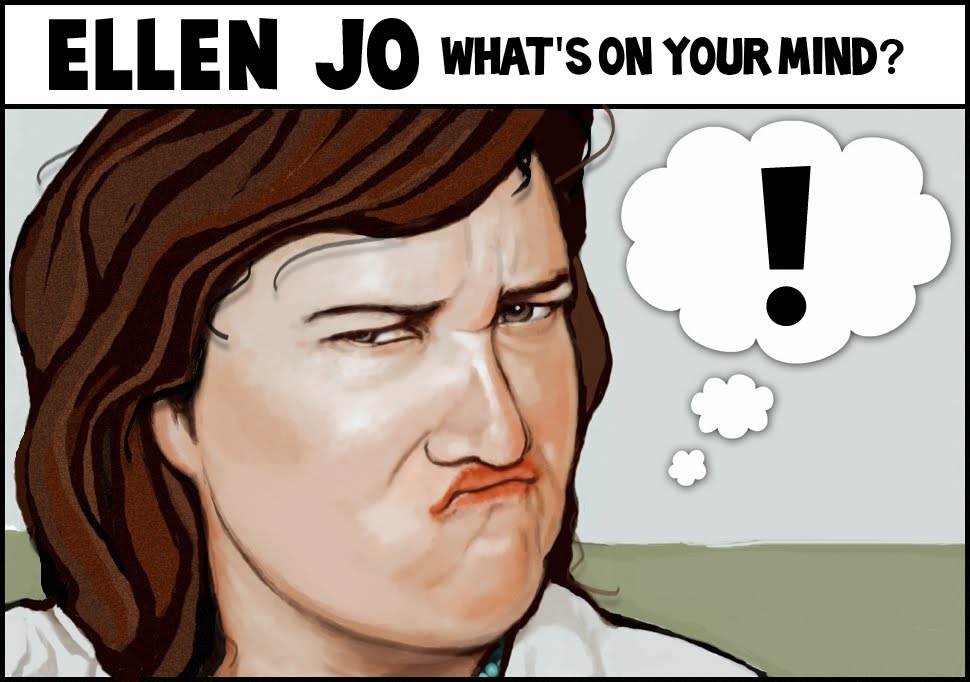Enchanted with the Four Corners
The Outs
The Noise
September 2013
by Ellen Jo Roberts
The Four Corners comes together neatly in a geometric fashion. You can put one hand in Utah, one hand in Colorado, one foot in Arizona and one foot in New Mexico and be in all four states at once like a crazy game of topographic Twister. Or, you can do like we did and cruise a big lazy loop around all of them one at a time.
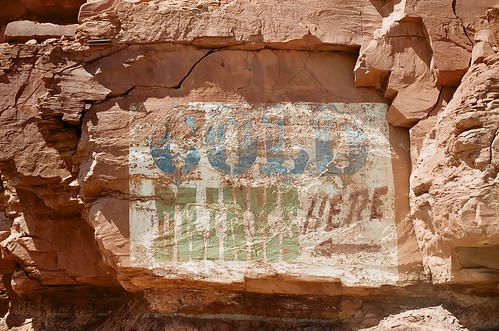
The first stop on our tour was Santa Fe. It bills itself as The City Different and being a bit of an oddball myself I felt right at home there.
"Riding the No. 2 Bus to the Plaza and making new friends, eating tamales from food trucks and rolling like locals here in Santa Fe"- written on post cards to pals.
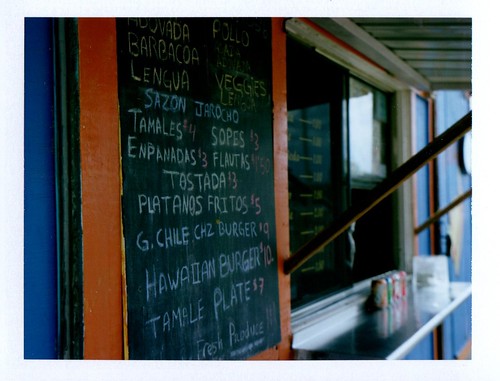
My first trip through Santa Fe was 18 summers ago, a quick one-night stopover on our move out west from Illinois, caravanning in our two vehicles packed with all of our worldly possessions. We camped just outside of the ski area, around 8,000 feet. I was a cranky brat, my head splitting with altitude sickness. My late, great Volkswagen Superbeetle was also crippled by the high elevation until a friendly local helped me adjust the carburetor. That was my last visit to Santa Fe. 1995! It seemed crazy that we've lived within a day's drive all of these years and had never journeyed back. The town gave me an expensive and slightly sinister vibe during that single brief visit, bathed in the sunset glow of strange graffiti, "no vacancy" signs, dirty looks, tension between the Native Americans, Chicanos and Anglos.

Returning again for a clearer look, I see I was all wrong about Santa Fe.
The City Different is bursting with diverse culture, tolerance and a general jubilance. There is a strong emphasis on the value of art in this town. It's everywhere you look, and it's definitely its own currency. History is also a commodity to be protected and savored. Local food and beverage are world class. Health is also an important focus, though the city is not without its share of drunks and toothless vagabonds. Nestled in the heaving bosoms of the Jemez and Sangre de Christo mountains Santa Fe's high desert climate makes for a pleasant spirit in its dwellers. Walking the Plaza, always just one step ahead of being lost, finding my way through the historic side streets, buzzing on the energy percolating up through this blessed ground, a rare thought came to me.
"I could live here."

The Silver Saddle Motel sits along the busy Cerrillos Road, a main thoroughfare through town. A vintage roadside adobe-style beauty built in 1953, the Silver Saddle was my first real introduction to the quirky Santa Fe style so emulated nationwide. The staff at the family-owned motel is delightfully eccentric and full of vivacity. The breakfast in the lobby each morning includes pastries, cereal, fruit, hard-boiled eggs and a good portion of socializing with other travelers. Beverages are served from a mismatched set of kitschy mid-century mugs. The gregarious front desk manager, charmingly draped in turquoise and decked in cool/nerdy eyeglasses, happened to mention her time in high school down to the south in Roswell. Famous actor/Wes Anderson pal Owen Wilson attended military school in Roswell, so I asked, "Did you know Owen Wilson?" "Yes," she laughed, "We actually were in the same graduating class together and in drama class together," and apparently they still maintain correspondence. Val Kilmer's autographed photo hangs nearby. Since he sold his long time Santa Fe home he likes to stay at the Silver Saddle, as it's "the real old skool Santa Fe."
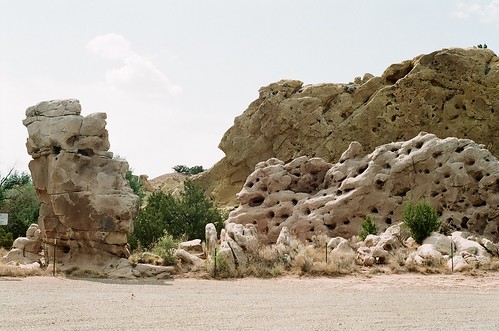
Also called Highway 14 or The Turquoise Trail, Cerrillos Road is a scenic two laner connecting Santa Fe to Albuquerque, and an alternative to Interstate 25. Picturesque relics dot the road its entire length: the ruins of an old mining town called Golden, a crowded biker burg called Madrid, and small, historic Cerrillos, an occasional film set. Up until the 1938, Route 66 traveled through Santa Fe and the historic portion of it shares a similar sensibility to the Mother Road elsewhere with its classic neon, railroad-town feel.
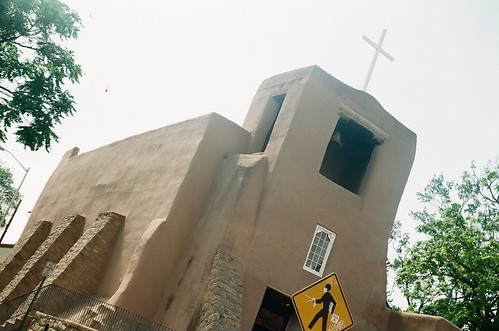
Santa Fe is the oldest capitol in the United States, and its ancient streets pre-date auto traffic by about 300 years, so the popular Plaza is generally crowded with cars and parking is tight. Another automobile note: Spendy Santa Fe is also the Porsche Capitol of the U.S.A. You can't cross the street without stepping in front of some German sports car. The Cerrillos Road No. 2 city bus stops just outside of the Silver Saddle. For $1.00 you can avoid driving and instead have some fun bilingual chats with the locals on public transportation. People in Santa Fe speak Spanish with great fluency; even the Anglo folk have nearly perfect accents. Our morning photo expeditions led us through all of the key historic sites like the San Miguel Mission, Loretto Chapel and its Miraculous Stairway, the Oldest House in the United States, the La Fonda Hotel, the Railyard and Canyon Road's famous row of art galleries. While buying postcards at the old 5 & 10 downtown one morning I managed to run into some random Arizona artist friend who had an on again/off again relationship with Northern New Mexico. "I knew I would catch up to you eventually," he said, exchanging his bike helmet for a giant velvet sombrero from high on a shelf. Santa Fe is chock full of such kismet.

The area is notably drier than our home base in Arizona’s Verde Valley. The Santa Fe “River” was a shockingly puny trickle and serious fire dangers had closed the National Forest during our summer visit. The lack of agua is a possible deal-breaker in the "I could live here" game. Being river town folks, we were craving some riparian life by the time we packed up and headed on for our next destination: Dolores, Colorado and a camping cabin along its eponymous cool grey-green river. On the road north, we stopped to see Abiquiu, about an hour from Santa Fe. Abiquiu is the place that inspired artist Georgia O'Keefe the very most. She lived there from 1949 ‘til 1984 and her home studio, "The Ghost Ranch", can be visited and an overnight stay can be arranged. The nearby Chama River snakes through red rock high desert and fragrant fields of sage. The geology of the area is at once familiar and completely foreign: rocks veined with strange geometry, alien formations and intense, saturated colors. I'd never seen anything like them before...except for, perhaps, in a painting by O'Keefe.
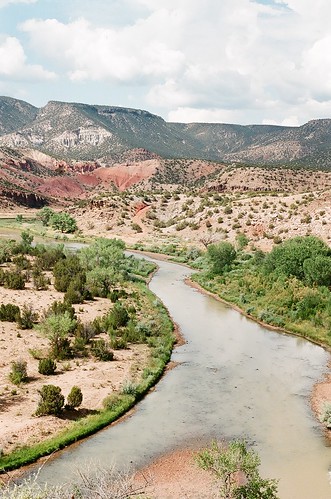
Further north, in Aztec, NM, along the Animas River, the Aztec National Monument is a display of ancient dwellings and similar to Tuzigoot, much of it rebuilt by WPA crews in the 1930s. Closer to the Colorado border, we are surprised by sight of a 20th century ruin, a lonely, abandoned structure along Highway 550 emblazoned with the name “Clarkdale”. It’s worth pulling a u-turn for a photo op, though later Google gives us no information about the building or why it wears the name of our Arizona home town.
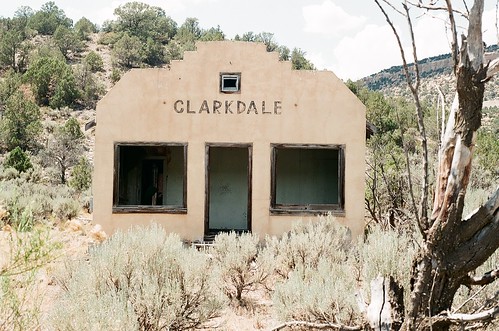
Dolores sits just below 7,000 feet in a mountain valley. It's an old railroad stop on the Rio Grande Southern Route, and home of the famous Galloping Goose No. 5, a crazy cool train contraption made from an old school bus mixed with a locomotive and painted silver. There are seven Geese total, all built in Ridgway in the 1930s and all still operational. The Galloping Goose was originally used to deliver mail between towns in the Southwestern Rockies. Goose No. 5 is parked outside its own museum in downtown Dolores, though on special occasions it goes journeying on the nearby Durango-Silverton and Cumbres and Toltec Railroads.
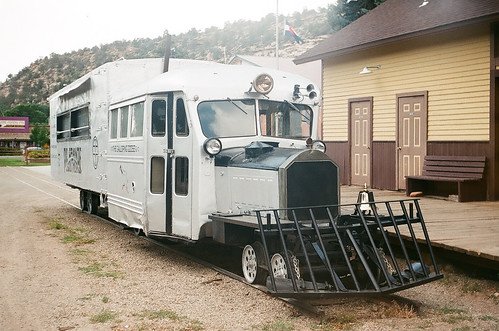
For a few nights we camped in a rustic cabin along the banks of the Dolores River. We spent every day hiking up on foot and floating down in rafts the rocky Dolores, and every night in a creaky old bed lulled to sleep by the river sounds as it hugged the edges of our rough hewn cabin home.
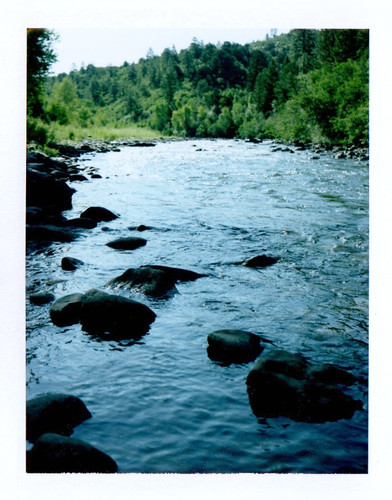
The town is small, tidy and historic and claims a pretty decent brewery. Assorted Dolores River Brewery ales can be purchased in canned 4-paks at the local liquor store. Also worth a try: Escalante Ruins at the Canyon of the Ancients visitor center. A mile hike up a sloping paved trail leads to a hilltop ruin and remnants of an ancient kiva. From this vantage point you can also see that the Dolores is dammed. The adjoining reservoir covers an old lumber town long gone called McPhee that gave its name to the lake that drowned it.
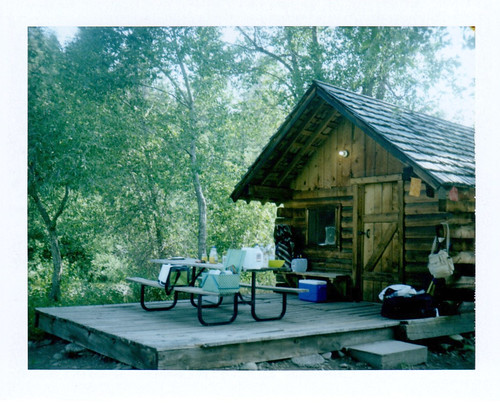

The most recent of stamps in our National Parks passport book was inked
at Hovenweep National Monument, a stop on our drive back home as we tallied time in each of the Four Corner states. Hovenweep is very remote, right on the Colorado/Utah border and about an hour from the closest town, Cortez, via the sparsely traveled Canyon of the Ancients route. What makes these ruins so impressive, in addition to their lovely canyonside perch, is that they were never rebuilt, or reinterpreted by WPA crews. Hovenweep is "stabilized" but original. Discovered in 1854 and protected by National Park status in 1923, these ancient towers and structures straddling two states are original to the 13th century.
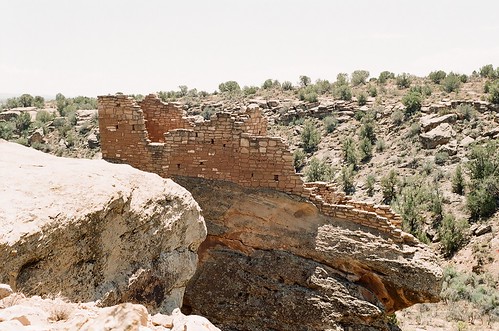
Through Utah we continued, a dot on the map slowly meandering back to Arizona. We took a wrong turn out of Hovenweep and suddenly have no idea where we are. Lost in the scenic west, we drive along curving, rolling and very nameless roads. No shoulder, no pavement markings, no speed limit signs. No worry, either. Not yet. The day was far too magical. We knew everything would work out. A promising intersection appears, inspiring hopes of being back on a main road, back on route. The new highway is not marked either, except for two burros standing nearby, eagerly awaiting our arrival.
“Wow, that’s how you know you’re REALLY lost. When the only ones you can ask directions from are a couple of donkeys.”
We burst into laughter. This is somehow everything wonderful and lovely about the western roads we've just spent the week wandering. The sense of being lost but not being scared. The open skies, beautiful rocks and the sun-baked surprises every mile. The feeling we're just small pieces of something much grander and anything is possible. The sense of enchantment. Our eyes are wide open for the next bit of magic down the road.
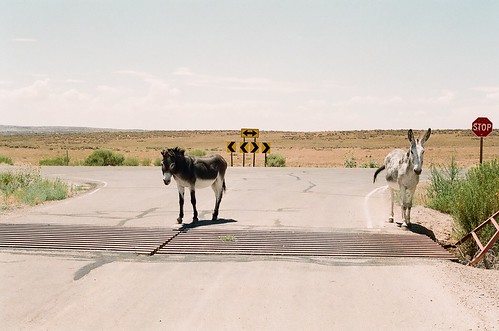
For more information:
silversaddlesantafe.com
doloresriverbrewery.com
www.nps.gov/hove/index.htm
Ellen Jo Roberts lives in Clarkdale Arizona with Chad, Floyd, Ivan, Ned and Hazel.
Read all about it at ellenjo.com
The Noise
September 2013
by Ellen Jo Roberts
The Four Corners comes together neatly in a geometric fashion. You can put one hand in Utah, one hand in Colorado, one foot in Arizona and one foot in New Mexico and be in all four states at once like a crazy game of topographic Twister. Or, you can do like we did and cruise a big lazy loop around all of them one at a time.

The first stop on our tour was Santa Fe. It bills itself as The City Different and being a bit of an oddball myself I felt right at home there.
"Riding the No. 2 Bus to the Plaza and making new friends, eating tamales from food trucks and rolling like locals here in Santa Fe"- written on post cards to pals.

My first trip through Santa Fe was 18 summers ago, a quick one-night stopover on our move out west from Illinois, caravanning in our two vehicles packed with all of our worldly possessions. We camped just outside of the ski area, around 8,000 feet. I was a cranky brat, my head splitting with altitude sickness. My late, great Volkswagen Superbeetle was also crippled by the high elevation until a friendly local helped me adjust the carburetor. That was my last visit to Santa Fe. 1995! It seemed crazy that we've lived within a day's drive all of these years and had never journeyed back. The town gave me an expensive and slightly sinister vibe during that single brief visit, bathed in the sunset glow of strange graffiti, "no vacancy" signs, dirty looks, tension between the Native Americans, Chicanos and Anglos.

Returning again for a clearer look, I see I was all wrong about Santa Fe.
The City Different is bursting with diverse culture, tolerance and a general jubilance. There is a strong emphasis on the value of art in this town. It's everywhere you look, and it's definitely its own currency. History is also a commodity to be protected and savored. Local food and beverage are world class. Health is also an important focus, though the city is not without its share of drunks and toothless vagabonds. Nestled in the heaving bosoms of the Jemez and Sangre de Christo mountains Santa Fe's high desert climate makes for a pleasant spirit in its dwellers. Walking the Plaza, always just one step ahead of being lost, finding my way through the historic side streets, buzzing on the energy percolating up through this blessed ground, a rare thought came to me.
"I could live here."

The Silver Saddle Motel sits along the busy Cerrillos Road, a main thoroughfare through town. A vintage roadside adobe-style beauty built in 1953, the Silver Saddle was my first real introduction to the quirky Santa Fe style so emulated nationwide. The staff at the family-owned motel is delightfully eccentric and full of vivacity. The breakfast in the lobby each morning includes pastries, cereal, fruit, hard-boiled eggs and a good portion of socializing with other travelers. Beverages are served from a mismatched set of kitschy mid-century mugs. The gregarious front desk manager, charmingly draped in turquoise and decked in cool/nerdy eyeglasses, happened to mention her time in high school down to the south in Roswell. Famous actor/Wes Anderson pal Owen Wilson attended military school in Roswell, so I asked, "Did you know Owen Wilson?" "Yes," she laughed, "We actually were in the same graduating class together and in drama class together," and apparently they still maintain correspondence. Val Kilmer's autographed photo hangs nearby. Since he sold his long time Santa Fe home he likes to stay at the Silver Saddle, as it's "the real old skool Santa Fe."

Also called Highway 14 or The Turquoise Trail, Cerrillos Road is a scenic two laner connecting Santa Fe to Albuquerque, and an alternative to Interstate 25. Picturesque relics dot the road its entire length: the ruins of an old mining town called Golden, a crowded biker burg called Madrid, and small, historic Cerrillos, an occasional film set. Up until the 1938, Route 66 traveled through Santa Fe and the historic portion of it shares a similar sensibility to the Mother Road elsewhere with its classic neon, railroad-town feel.

Santa Fe is the oldest capitol in the United States, and its ancient streets pre-date auto traffic by about 300 years, so the popular Plaza is generally crowded with cars and parking is tight. Another automobile note: Spendy Santa Fe is also the Porsche Capitol of the U.S.A. You can't cross the street without stepping in front of some German sports car. The Cerrillos Road No. 2 city bus stops just outside of the Silver Saddle. For $1.00 you can avoid driving and instead have some fun bilingual chats with the locals on public transportation. People in Santa Fe speak Spanish with great fluency; even the Anglo folk have nearly perfect accents. Our morning photo expeditions led us through all of the key historic sites like the San Miguel Mission, Loretto Chapel and its Miraculous Stairway, the Oldest House in the United States, the La Fonda Hotel, the Railyard and Canyon Road's famous row of art galleries. While buying postcards at the old 5 & 10 downtown one morning I managed to run into some random Arizona artist friend who had an on again/off again relationship with Northern New Mexico. "I knew I would catch up to you eventually," he said, exchanging his bike helmet for a giant velvet sombrero from high on a shelf. Santa Fe is chock full of such kismet.

The area is notably drier than our home base in Arizona’s Verde Valley. The Santa Fe “River” was a shockingly puny trickle and serious fire dangers had closed the National Forest during our summer visit. The lack of agua is a possible deal-breaker in the "I could live here" game. Being river town folks, we were craving some riparian life by the time we packed up and headed on for our next destination: Dolores, Colorado and a camping cabin along its eponymous cool grey-green river. On the road north, we stopped to see Abiquiu, about an hour from Santa Fe. Abiquiu is the place that inspired artist Georgia O'Keefe the very most. She lived there from 1949 ‘til 1984 and her home studio, "The Ghost Ranch", can be visited and an overnight stay can be arranged. The nearby Chama River snakes through red rock high desert and fragrant fields of sage. The geology of the area is at once familiar and completely foreign: rocks veined with strange geometry, alien formations and intense, saturated colors. I'd never seen anything like them before...except for, perhaps, in a painting by O'Keefe.

Further north, in Aztec, NM, along the Animas River, the Aztec National Monument is a display of ancient dwellings and similar to Tuzigoot, much of it rebuilt by WPA crews in the 1930s. Closer to the Colorado border, we are surprised by sight of a 20th century ruin, a lonely, abandoned structure along Highway 550 emblazoned with the name “Clarkdale”. It’s worth pulling a u-turn for a photo op, though later Google gives us no information about the building or why it wears the name of our Arizona home town.

Dolores sits just below 7,000 feet in a mountain valley. It's an old railroad stop on the Rio Grande Southern Route, and home of the famous Galloping Goose No. 5, a crazy cool train contraption made from an old school bus mixed with a locomotive and painted silver. There are seven Geese total, all built in Ridgway in the 1930s and all still operational. The Galloping Goose was originally used to deliver mail between towns in the Southwestern Rockies. Goose No. 5 is parked outside its own museum in downtown Dolores, though on special occasions it goes journeying on the nearby Durango-Silverton and Cumbres and Toltec Railroads.

For a few nights we camped in a rustic cabin along the banks of the Dolores River. We spent every day hiking up on foot and floating down in rafts the rocky Dolores, and every night in a creaky old bed lulled to sleep by the river sounds as it hugged the edges of our rough hewn cabin home.

The town is small, tidy and historic and claims a pretty decent brewery. Assorted Dolores River Brewery ales can be purchased in canned 4-paks at the local liquor store. Also worth a try: Escalante Ruins at the Canyon of the Ancients visitor center. A mile hike up a sloping paved trail leads to a hilltop ruin and remnants of an ancient kiva. From this vantage point you can also see that the Dolores is dammed. The adjoining reservoir covers an old lumber town long gone called McPhee that gave its name to the lake that drowned it.


The most recent of stamps in our National Parks passport book was inked
at Hovenweep National Monument, a stop on our drive back home as we tallied time in each of the Four Corner states. Hovenweep is very remote, right on the Colorado/Utah border and about an hour from the closest town, Cortez, via the sparsely traveled Canyon of the Ancients route. What makes these ruins so impressive, in addition to their lovely canyonside perch, is that they were never rebuilt, or reinterpreted by WPA crews. Hovenweep is "stabilized" but original. Discovered in 1854 and protected by National Park status in 1923, these ancient towers and structures straddling two states are original to the 13th century.

Through Utah we continued, a dot on the map slowly meandering back to Arizona. We took a wrong turn out of Hovenweep and suddenly have no idea where we are. Lost in the scenic west, we drive along curving, rolling and very nameless roads. No shoulder, no pavement markings, no speed limit signs. No worry, either. Not yet. The day was far too magical. We knew everything would work out. A promising intersection appears, inspiring hopes of being back on a main road, back on route. The new highway is not marked either, except for two burros standing nearby, eagerly awaiting our arrival.
“Wow, that’s how you know you’re REALLY lost. When the only ones you can ask directions from are a couple of donkeys.”
We burst into laughter. This is somehow everything wonderful and lovely about the western roads we've just spent the week wandering. The sense of being lost but not being scared. The open skies, beautiful rocks and the sun-baked surprises every mile. The feeling we're just small pieces of something much grander and anything is possible. The sense of enchantment. Our eyes are wide open for the next bit of magic down the road.

For more information:
silversaddlesantafe.com
doloresriverbrewery.com
www.nps.gov/hove/index.htm
Ellen Jo Roberts lives in Clarkdale Arizona with Chad, Floyd, Ivan, Ned and Hazel.
Read all about it at ellenjo.com
